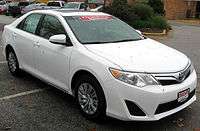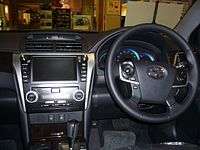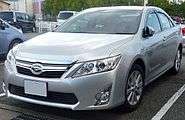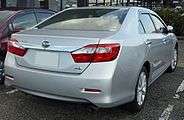Toyota Camry (XV50)
| Toyota Camry (XV50) | |
|---|---|
_July_2012.jpg) | |
| Overview | |
| Manufacturer | Toyota |
| Also called |
Daihatsu Altis (prestige) (Japan; 2012–present) Toyota Aurion (prestige) (Australia; 2012–present) |
| Production |
21 August 2011 – present (US)[1] October 2011 – present (Australia) November 2011 – present (Russia) February 2012 – present (Aurion) |
| Model years | 2012–present |
| Assembly |
Japan: Toyota, Aichi (Tsutsumi plant)[2] Australia: Altona, Victoria (TMCA) China: Guangzhou, Nansha India: Bidadi (TKML) Indonesia: Sunter (TAM) Malaysia: Shah Alam Russia: Saint Petersburg Taiwan: Kuanying (Kuozui Motors) Thailand: Chachoengsao United States: Georgetown, Kentucky (TMMK); Lafayette, Indiana (SIA) |
| Designer |
Hirotada Kobayashi and Tomonori Matsumoto (regular: 2009)[3] Kentarou Asakura (sports version, regular: 2009)[4] Hirofumi Fukui and Kazumi Kowaki (prestige: 2009)[5] Keisuke Matsuno (hybrid version, prestige: 2009)[6] |
| Body and chassis | |
| Layout | Front-engine, front-wheel drive |
| Platform | Toyota K platform |
| Powertrain | |
| Engine |
2.0 L 1AZ-FE I4 145hp 2.5 L 2AR-FE I4 178hp-181hp 3.5 L 2GR-FE V6 268hp 2.5 L 2AR-FXE I4 154hp Hybrid |
| Transmission |
4-speed automatic 6-speed automatic Hybrid: CVT |
| Dimensions | |
| Wheelbase | 2,775 mm (109.3 in) |
| Length |
4,850 mm (190.9 in) (US & Asia) 4,820 mm (189.8 in) |
| Width | 1,820 mm (71.7 in) |
| Height | 1,470 mm (57.9 in) |
| Curb weight |
1,447 kg (3,190 lb) (LE) 1,470 kg (3,240 lb) (SE) 1,540 kg (3,395 lb) (XLE V6) 1,551 kg (3,420 lb) (SE V6) |
| Chronology | |
| Predecessor |
Toyota Camry (XV40) (regular) Toyota Aurion (XV40) (prestige) |
The Toyota Camry (XV50) is a mid-size car that has been produced by Toyota since August 2011. Replacing the XV40 series, the XV50 represents the seventh generation of the Toyota Camry in all markets outside Japan, which follows a different generational lineage.
Development
The new Camry was introduced on 23 August 2011 and made its debut in the 2011 NASCAR Sprint Cup Series on 27 August 2011. It was released in Japan on 5 September 2011 and in the U.S. later that same month.[7] The interior received a major restyling, while the exterior received all-new sheet metal and more angular styling. Power options are the 2.5-liter 2AR-FE 4-cylinder and the 3.5-liter 2GR-FE V6. The power output for the 2AR-FE was increased to 133 kW (178 hp) across the entire product line while the power output for the V6 remained unchanged. EPA fuel economy numbers for both engines increased, with the V6 engine increased to 11 L/100 km; 25 mpg-imp (21 mpg-US) city cycle, 8 L/100 km; 36 mpg-imp (30 mpg-US) highway cycle and the 4-cylinder having 9 L/100 km; 30 mpg-imp (25 mpg-US) city cycle and 7 L/100 km; 42 mpg-imp (35 mpg-US) highway cycle.[8] The engine produces 230 N·m (170 lbf·ft) of torque. Despite similar exterior dimensions with the XV40 Camry, Toyota was able to increase the interior volume by restyling the interior panels so that they followed the contour of the exterior panels.
The XV50 Camry is the first Camry to be offered in the U.S. without a manual transmission. The U.S. Camry has a 6-speed automatic transmission, with SE models featuring paddle shifters for manual shifts. CVT is still offered on hybrid models. In Japan, the new Camry is exclusive to Toyota Corolla Store locations.
The 2013 model year Camry was released in Japan on 3 September 2012, but was delayed in the U.S. until late January 2013 due to power shortages in Japan caused by the 2011 Tōhoku earthquake and tsunami. For the first time, the Japanese market Camry did not use the "regular" Camry design used for US and Australian models. Instead, it adopts the "prestige" Camry or Aurion design that Southeast Asia and China have received.
Equipment
United States
The SE model is fitted with a sports-tuned suspension, 17-inch alloy wheels (with 18-inch alloys on V6 models), fog lamps, a leather-wrapped steering wheel and shifter, sport seats, and shift paddles to differentiate it from the rest of the line-up.
Prices in the U.S. start at US$21,955. The SE, XLE trims and the hybrid had no price change or a reduction of between $200 and $2000 with respect to the previous year. The Camry LE received a price increase of $710, while the new base level Camry L was introduced to the lineup.[9]
Engines
| Type | Model years | Power | Torque |
|---|---|---|---|
| 2494 cc 2AR-FE inline-four | 2012–present | 178 bhp (133 kW) @ 6000 rpm | 171.85 lb·ft (233 N·m) @ 4100 rpm |
| 2494 cc 2AR-FXE inline-four (hybrid) | 2012–present | 202 bhp (151 kW) @ 5700 rpm | 157 lb·ft (213 N·m) @ 4500 rpm |
| 3456 cc 2GR-FE V6 | 2012–present | 268 bhp (200 kW) @ 6200 rpm | 248 lb·ft (336 N·m) @ 4700 rpm |
|
Australasia
Introduced in late 2011, the XV50 series Camry in Australia and New Zealand was sold under a new two-tier naming and styling structure. For the gasoline models (ASV50R), Altise remains the base model while Ateva, Sportivo and Grande have been replaced by the Atara S, SX and SL. Australian Camrys have different interior fabrics, colour, and trim as well as the steering and suspension settings that were adapted for the local market. The Altise (base) starts at A$30,490 and the Atara SL (top-end) is A$39,990.
The XV50 series (AVV50R) Camry Hybrid was released to the Australian market in early 2012, and is available in two variants, the lower grade "h" (partially based on the Atara S) and the higher grade "hL" (based on the Atara SL). The hybrid models are differentiated to the petrol models by having a unique chrome grille and additional hybrid badging.
Toyota Australia also released limited-run models of the ASV50R, including the Atara R, and RZ.[10]
The facelift version of the XV50 started production in Australia on 28 April 2015.[11]
|
2014 facelift
_Atara_S_sedan_(2016-03-19).jpg)
_Atara_S_sedan_(19612176942).jpg)
.jpg)
_02.jpg)
Toyota introduced a substantial mid-cycle restyling to the Camry XV50 at the 2014 New York International Auto Show in April 2014. The changes, applicable to the entire Camry range and dubbed the "big minor change" (not a new generation), consisted mainly of the alteration of most of the exterior panels – only the roof remained unchanged. The powertrain remained unchanged from the pre-facelift model.
The facelift included an aggressive front bumper featuring a wider and more prominent trapezoidal grille shape. The interior received a more premium appearance, with improved materials and amenities. The window and door seals were improved to reduce wind and road noise.[12][13]
Toyota started production of restyled Camry for Russian market in November 2014. The car has a new design and a new 2.0 L 6AR-FSE engine, 150 bhp (112 kW), paired with a 6-speed automatic gearbox.[14]
Toyota Australia commenced production of the facelift 50 Series Camry for the Australian market in April 2015.
In February 2015, for the 2016 model year, Toyota released the Special Edition Camry for the US market—limited to 12,000 units. Based on the SE model, it has unique black gloss and silver painted 18-inch alloy wheels, blue accents and stitching throughout the interior including the seats, white-faced gauges with aluminum trim, smoked taillights, Special Edition floor mats and trunk emblem. Added standard equipment include a power moonroof, keyless entry and ignition, and a Qi inductive charge pad for mobile phones. The only option was a navigation system. Available colors unique to the Special Edition Camry were either Blizzard Pearl (white) or Blue Streak Metallic. These two colors joined the regular color palette for the 2017 model year, although only available on SE and XSE models.[15]
Camry Hybrid

The Camry Hybrid received improvements, including a revised version of the Hybrid Synergy Drive, paired with an Atkinson cycle version of the standard 2AR-FE 2.5-liter 4-cylinder, the 2AR-FXE. The engine delivers net system power of 149 kW (200 bhp), up from 139 kW (187 bhp) in the previous model, and allows the new model to achieve a 39% increase in fuel economy rating, giving the Camry Hybrid best MPG ratings among mid-size sedans.[16][17] The Camry Hybrid uses a 1.6 kWh sealed nickel-metal hydride traction battery.[18]
It has a drag coefficient of Cd=0.27, which in Australia makes it the most aerodynamic locally produced car,[19] the same as its XV40 predecessor.[20]
| Grade[21] | City | Highway | Combined |
|---|---|---|---|
| LE | 5.5 L/100 km (43 mpg-US) | 6.0 L/100 km (39 mpg-US) | 5.7 L/100 km (41 mpg-US) |
| XLE | 5.9 L/100 km (40 mpg-US) | 6.2 L/100 km (38 mpg-US) | 5.9 L/100 km (40 mpg-US) |
|
Asian version
The Asian version of the Camry was designed in Japan by Hirofumi Fukui, Kazumi Kowaki and Keisuke Matsuno in 2009. It is referred to as the "prestige Camry" by Toyota officials in Japan. The prestige Camry is also manufactured and sold in Australia as the Toyota Aurion (XV50), which was launched there in April 2012. In Indonesia and Malaysia, the prestige Camry was launched in June 2012 and also available in a hybrid drivetrain. This was the first Camry in Indonesia and Malaysia to equip with a hybrid drivetrain. The prestige Camry, sold in Japan and other Asian markets, received a large facelift in 2014 (for the 2015 model year). However, the Aurion itself in Australia have not received the same treatment, but rather a much smaller facelift based on the original design.
|
See also
![]() Media related to Category:Toyota Camry (XV50) at Wikimedia Commons
Media related to Category:Toyota Camry (XV50) at Wikimedia Commons
References
- ↑ "A look at Toyota's 25 years in Kentucky". KyForward. Lexington, Kentucky. Archived from the original on 2014-11-12.
- ↑ "Japanese Production Sites". Toyota. 2015-03-06. Archived from the original on 2015-03-18.
- ↑ "Automobile and/or toy replica thereof: US D667342 S1". Google Patents. Retrieved 2016-11-19.
- ↑ "Automobile and/or toy replica thereof: US D667756 S1". Google Patents. Retrieved 2016-11-16.
- ↑ "Automobile and/or toy replica thereof: US D667343 S1". Google Patents. Retrieved 2016-11-19.
- ↑ "Automobile and/or toy replica thereof: US D667344 S1". Google Patents. Retrieved 2016-09-16.
- ↑ Lienert, Anita (2011-09-02). "2012 Toyota Camry To Hit Showrooms Ahead of Schedule". Edmunds.com. Retrieved 2012-05-09.
- ↑ "Vehicle Table - 2012 Toyota Camry". U.S. Department of Energy and U.S. Environmental Protection Agency (fueleconomy.gov). Retrieved 2012-08-22.
- ↑ Stoklosa, Alexander (2011-08-23). "Toyota Prices 2012 Camry from $22,715; Hybrid Model Rated at 43 mpg City". Car and Driver. Retrieved 2011-08-29.
- ↑ Beissmann, Tim (2011-12-07). "2012 Toyota Camry prices and specifications". CarAdvice. Retrieved 2012-01-01.
- ↑ Beissmann, Tim (2015-04-28). "2015 Toyota Camry production kicks off at Altona". Car Advice. Retrieved 2015-11-18.
- ↑ Antony Ingram (2014-04-17). "2015 Toyota Camry: New York Auto Show Live Photos". Green Car Congress. Retrieved 2014-04-17.
- ↑ Jerry Hirsh (2014-04-16). "New York Auto Show: Toyota shows off new aggressive Camry styling". Los Angeles Times. Retrieved 2014-04-17.
- ↑ "Production of restyled Toyota Camry sedan started on November 5". Wroom.ru. 2014-11-05. Retrieved 2014-11-12.
- ↑ Wendler, Andrew (2015-02-05). "I'm Special, So Special: 2016 Toyota Camry Special Edition Gonna Make You Notice". Car and Driver. Retrieved 2016-08-17.
- ↑ "Toyota introduces 7th generation Camry for 2012 with improved fuel economy and performance across all models; ~39% jump in EPA city cycle fuel economy for the hybrid". Green Car Congress. 2011-08-23. Retrieved 2012-05-09.
- ↑ Loveday, Eric (2011-08-29). "How the 2012 Toyota Camry Hybrid differs from its predecessor". AutoblogGreen. Retrieved 2012-05-09.
- ↑ Josh Pihl (January 2014). "Table 33. Batteries for Selected Hybrid-Electric Vehicles, Model Years 2013-2014". Oak Ridge National Laboratory. Retrieved 2014-11-21.
- ↑ "2015 Toyota Camry brochure (US)" (PDF). Toyota Motor Sales, U.S.A., Inc. 2014. Archived from the original (PDF) on 2014-10-21.
- ↑ Hammerton, Ron (2009-12-21). "Camry Hybrid cuts the drag". GoAuto. Retrieved 2016-01-11.
- ↑ "Compare side-by-side: 2012 Toyota Camry". U.S. Department of Energy and U.S. Environmental Protection Agency (fueleconomy.gov). Retrieved 2012-08-22. The comparison shows fuel economy for the Camry Hybrid trims LE and XLE, and the gasoline-powered models with 2.5L and 3.5L engines.
| « previous — Toyota road car timeline, North American market, 1980s–present (model years) | ||||||||||||||||||||||||||||||||||||||
|---|---|---|---|---|---|---|---|---|---|---|---|---|---|---|---|---|---|---|---|---|---|---|---|---|---|---|---|---|---|---|---|---|---|---|---|---|---|---|
| Type | 1980s | 1990s | 2000s | 2010s | ||||||||||||||||||||||||||||||||||
| Model year | 0 | 1 | 2 | 3 | 4 | 5 | 6 | 7 | 8 | 9 | 0 | 1 | 2 | 3 | 4 | 5 | 6 | 7 | 8 | 9 | 0 | 1 | 2 | 3 | 4 | 5 | 6 | 7 | 8 | 9 | 0 | 1 | 2 | 3 | 4 | 5 | 6 | 7 |
| Subcompact | Tercel | Tercel | Tercel | Tercel | Tercel | Echo | Yaris Sedan | Yaris iA | ||||||||||||||||||||||||||||||
| Yaris Liftback | Yaris Liftback | |||||||||||||||||||||||||||||||||||||
| Starlet | Corolla FX | Prius c | ||||||||||||||||||||||||||||||||||||
| Corolla | Corolla | |||||||||||||||||||||||||||||||||||||
| Compact | Corolla | Corolla | Corolla | Corolla | Corolla | Corolla | ||||||||||||||||||||||||||||||||
| Matrix | Matrix | Corolla iM | ||||||||||||||||||||||||||||||||||||
| Corona | Camry | Camry | Prius | |||||||||||||||||||||||||||||||||||
| Mid-size | Prius | Prius | Prius | |||||||||||||||||||||||||||||||||||
| Cressida | Cressida | Cressida | Cressida | Camry Solara | Camry Solara | Prius v | ||||||||||||||||||||||||||||||||
| Camry | Camry | Camry | Camry | Camry | ||||||||||||||||||||||||||||||||||
| Mirai | ||||||||||||||||||||||||||||||||||||||
| Full-size | Avalon | Avalon | Avalon | Avalon | ||||||||||||||||||||||||||||||||||
| Sport compact | Corolla GT-S/SR5 | |||||||||||||||||||||||||||||||||||||
| Celica | Celica | Celica | Celica | Celica | Celica | |||||||||||||||||||||||||||||||||
| Paseo | Paseo | |||||||||||||||||||||||||||||||||||||
| Sports car | Celica Supra | Celica Supra | 86 | |||||||||||||||||||||||||||||||||||
| Supra | Supra | |||||||||||||||||||||||||||||||||||||
| MR2 | MR2 | MR2 Spyder | ||||||||||||||||||||||||||||||||||||

_Altise_sedan_(2015-10-18)_01.jpg)
_Altise_sedan_(2015-06-03)_02.jpg)
_Atara_S_sedan_(2016-07-07)_01.jpg)
_Atara_S_sedan_(2015-05-29)_03.jpg)
.jpg)
.jpg)
_Hybrid_H_sedan_(2015-07-03)_01.jpg)
_Hybrid_H_sedan_(2015-07-03)_02.jpg)
%2C_Karangasem.jpg)
%2C_Karangasem.jpg)




